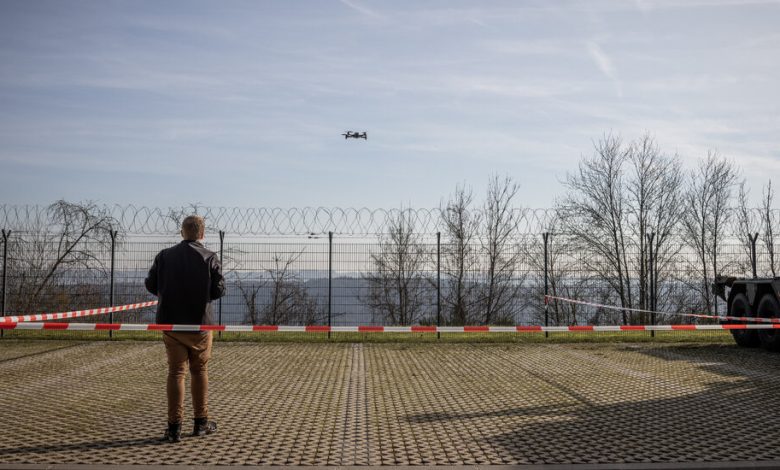How a Tiny NATO Nation Tackled a Big Problem: Arming Ukraine

LUXEMBOURG — Luxembourg’s military consists of fewer than 1,000 troops, one cargo plane, two helicopters shared with police forces and fewer than 200 trucks, ranging from Humvees to about 10 state-of-the-art Dingo combat reconnaissance vehicles.
There are no tanks, warplanes or Patriot air defense missiles to contribute to the Western push to arm Ukraine. The 102 anti-tank missiles and 20,000 rounds of machine gun ammunition Luxembourg has sent from its arsenal were as many weapons as it could afford to give without putting its own military readiness at risk.
So Luxembourg, a nation with a population of 640,000, decided to use its considerable wealth to try to buy weapons for Ukraine on the open market, and signed a multimillion-dollar deal last spring for 6,000 Soviet-era rockets. In the end, though, the government delivered only 600 and was left scrambling for ways to spend the money.
At a time when Western stocks of Soviet-era weapons and ammunition are running low, Luxembourg’s travails provide a window on the vexing problem of supplying Ukraine with the arms it needs to hold off Russia until the arrival of sophisticated Western rockets, missiles and tanks later this year.
Ukraine has been burning through ammunition at a prodigious rate since the start of the war, relying on allies to replace its stocks. But there are no weapons producers in Luxembourg, and the government had already given all it judged it could afford from its own limited arsenal.
But determined to make a greater contribution to the war effort, Luxembourg set up a two-man team of in-house arms dealers soon after the Russian invasion. They set out to scour commercial weapons markets in Europe and the United States, and to demonstrate that their country’s commitment to defeating Russia was every bit as big as that of its much larger NATO partners.
“We are so small, and we have no large army, and therefore limited stock, and we wanted from the beginning to help Ukraine,” Luxembourg’s defense minister, Francois Bausch, who also doubles as the country’s transportation minister and deputy prime minister, said in a recent interview. “But we are flexible, and so we can go and buy on the market what they need and deliver it directly to them.”
He also drew a parallel to Luxembourg’s history as an invaded state during World War I and World War II. “We were occupied many times in the last century, so we have an enormous sensibility for what it means for what is now happening in Ukraine,” Mr. Bausch said.
He added: “We cannot let Putin do what he intends.”
Most NATO states are donating from their own military stockpiles, in a fairly straightforward process, but some also are snapping up arms for sale on commercial markets.
But that is murkier business, particularly when buying Soviet-era weapons that otherwise are of little use to NATO, from sellers who may not want to be identified for fear of jeopardizing their business by angering Russia.
The men of Luxembourg’s new arms-buying unit knew little of this when they struck out across Europe. They soon discovered they could place an order for the Soviet-era rockets, BM-21 Grads, to be built at a manufacturing plant in the Czech Republic — a natural fit, they thought, for Ukrainian troops already trained in their use. But as is common in the unpredictable world of weapons procurement, the deal soon went sideways.
The State of the War
- Vuhledar: A disastrous Russian assault on the Ukrainian city, viewed as an opening move in an expected spring offensive, has renewed doubts about Moscow’s ability to sustain a large-scale ground assault.
- A Sea of Crosses: A bleak, snowy cemetery is filling with more and more dead soldiers from the Wagner mercenary forces, a sign of the huge casualties Russia is suffering in Ukraine.
- Bakhmut: With Russian forces closing in, Ukraine is barring aid workers and civilians from entering the besieged city, in what could be a prelude to a Ukrainian withdrawal.
- Arms Supply: Ukraine and its Western allies are trying to solve a fundamental weakness in its war effort: Kyiv’s forces are firing artillery shells much faster than they are being produced.
Grappling with high demand for Grads after the war began, the Czech manufacturer ran out of parts. To make matters worse, most of the company’s suppliers were located in Russia or countries that refused to export equipment that could be used to help Ukraine. In the end, Luxembourg had to settle for the 600 rockets, one tenth its original goal.
Not all of the country’s deals have gone south. It has managed to deliver or contract for approximately $94 million in weapons and other military assistance for Ukraine from manufacturers in Britain, France, Poland and the Netherlands — about 16 percent of the country’s defense budget, Mr. Bausch said.
But it has been a struggle, and that is still a tiny amount compared to the billions of dollars in security assistance that NATO powers like Britain, Germany and the United States have given Ukraine since last February. Those three countries alone have pledged nearly $40 billion so far.
Anna-Lena Högenauer, an associate professor of political science and international relations at the University of Luxembourg, said the government appeared to be grappling with its longstanding qualms about military entanglement, despite public support for Ukraine.
“Luxembourg has less of a tradition and certainly less experience getting involved in conflicts,” Ms. Högenauer said. “It’s a little bit out of the comfort zone of a small state that doesn’t really think in military terms.”
Luxembourg spends less on its military than any other NATO country, and was the only state in the alliance to contribute less than 1 percent of its gross domestic product to national defense last year. (NATO members have pledged to spend at least 2 percent of their G.D.P. to defense, but only about one-third of the 30 states currently do so.)
And Luxembourg, with a G.D.P. above $130,000 per person — by far the highest in NATO — has contributed only $25 million to Ukraine in humanitarian aid and contributions to NATO and European Union programs that are supporting Kyiv, according to data provided by its government.
That has drawn rebukes from otherwise supportive allies, particularly against the backdrop of the ongoing conflict in Ukraine.
“The rapidly evolving security context compels us to find arguments for doing more, rather than reasons doing so would be difficult,” the American ambassador to Luxembourg, Thomas M. Barrett, wrote in an op-ed last June.
But Luxembourg officials said it is more complicated than that. Even if the government decided to devote more money to supply Ukraine’s military, Mr. Bausch said, there are not enough people in his department to decide how to spend it quickly and without risk of it being misused.
And there remains the problem of finding weapons to buy, as the two in-house arms dealers — both military officers who have deployed to conflict zones — soon found out.
In a wide-ranging interview this month, in which they insisted on anonymity for security reasons, the pair described painstaking, often frustrating negotiations with commercial brokers, cold calls to manufacturers and even Google searches to track down weapons that Ukraine says it needs.
Ammunition remains high on the list, but sometimes the hunt for it leads to a dead end. Sometimes prices have been inflated. In other cases, they said, other buyers — including other allied countries — have snatched up the matériel before they could close the deal.
And then there is case of the BM-21 Grad rockets, which fell short because of manufacturing limits. All was not lost, however, as the Luxembourg arms dealers swiftly contracted with the same Czech manufacturer to buy ammunition of both NATO and Soviet-era calibers, to be delivered later this spring. The manufacturer, who the dealers asked not be identified for security reasons, also sold them 12,500 RPG-7 anti-tank grenades, a version of a Soviet weapon; they were delivered to Ukraine in the first few months of the war.
The dealers said there is little room for negotiation on prices, given that the weapons are in such high demand. And, if all goes smoothly, which is far from assured, it takes at least two weeks to vet the sale, draw up the contract and run it through the necessary approvals.
So far, they said, they are not buying from states in Africa, eastern Asia, the Middle East and South America that are flush with Soviet-era weapons, out of concern that the arms may be too old to be potent, or about potential bribery demands.
Camille Grand, who until last year was NATO’s chief defense investment official, said Luxembourg’s efforts were interesting as an example of how nations are quietly working the seams to continue arming Ukraine despite dwindling stockpiles, manufacturing shortages and stretched budgets.
“It’s a sort of matchmaking between those with money and those with some capacity,” Mr. Grand said.




